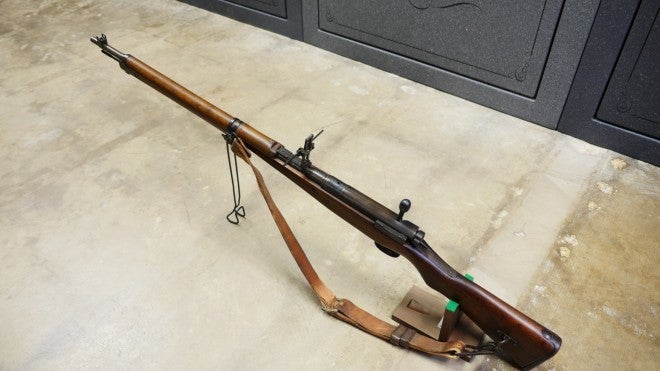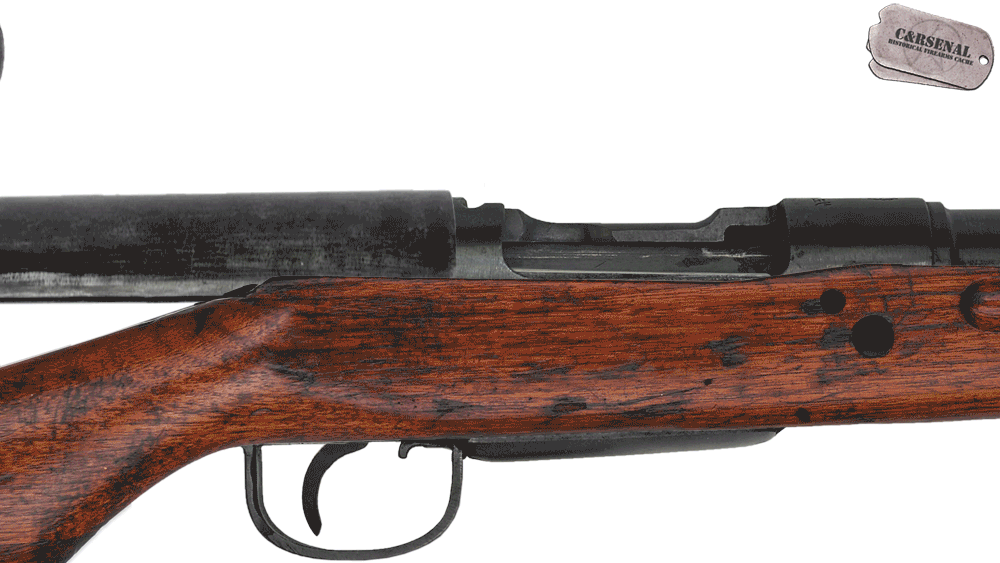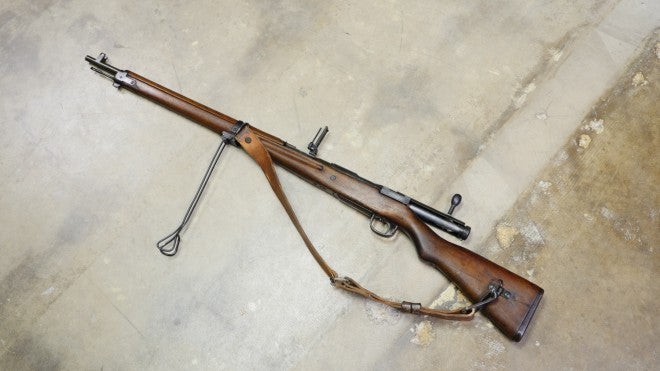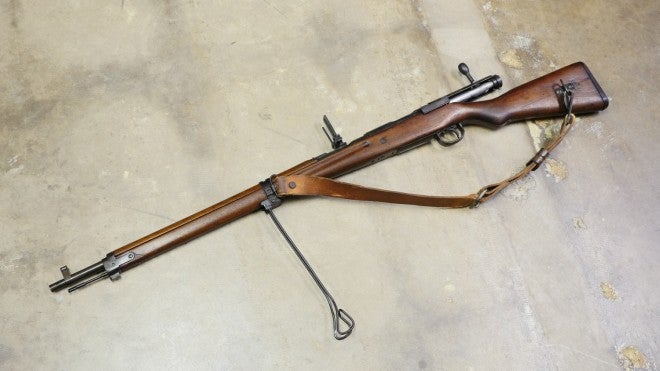For today’s Friday Field Strip, we’re looking at the Japanese Type 99, a rifle with more than meets the eye. The Type 99, commonly but somewhat erroneously called the “Arisaka”, is a rifle that was once widely known as a crude, last ditch weapon of the Japanese Empire, but which has since become well-respected among modern collectors and historians, with many even considering it to be the best bolt-action of the Second World War.
The Type 99 was a development of Kijiro Nambu’s Type 38 rifle, shortened, and rechambered for the new Japanese 7.7mm rifle cartridge. Strangely, two other 7.7mm cartridges were in use with the Japanese armed forces at the time; one that was a virtual clone of the British .303 caliber in use with the Navy for aircraft machine guns, and another that was a unique, semi-rimmed machine gun round in use with the IJA in their machine guns. The 7.7mm rifle round, however, was a distinct development, dating back to the Russo-Japanese War. In that conflict, Japanese soldiers observed that the round-nosed 6.5mm ammunition then standard issue was giving lackluster terminal ballistics, especially at long ranges. As a result, the IJA undertook to develop a more powerful round, of 7.7mm caliber. This project was shelved, however, when the experience of the Great War made it clear that new support weapons like the infantry mortar had greatly reduced the importance of long-range rifle fire, and while the IJA still desired a larger round than the 6.5mm, it was not considered worth the logistical upset. In 1923, the Great Kantō Earthquake devastated the Japanese capital, damaging the Itabashi powder plant and the Koishikawa arsenal. It was determined that the latter would be too costly to repair, and so the arsenal was moved to Kokura, more than 500 miles away. This essentially halted development of the project, and, with the exception of some testing in 1929, major progress would not again begin on a 7.7mm bore infantry rifle until 1938. By 1905, the Japanese had adopted a much more effective 139gr spitzer projectile for the 6.5mm cartridge, but the development of the 7.7mm continued; whether this was because it was perceived to give even greater effectiveness (by the 1930s, the Japanese were fighting Chinese opponents armed with Mausers in the larger German 7.9mm caliber) than the Type 38 spitzer round, or for some other reason is unknown to me. The final 7.7x58mm rimless cartridge adopted with the Type 99 rifle fired a 182gr flat-based spitzer bullet of modest shape at an equally modest 2,400 ft/s muzzle velocity. As a final note, some source documents (in Japanese) regarding the development of 7.7mm ammunition are available at this link, if any bilingual readers are interested.
C&Rsenal’s excellent article on the Type 99 covers the changes made to the rifle from the Type 38; while I could restate them in my own words, the information would be identical:
A set of guns, consisting of an infantry long rifle and a cavalry carbine, were developed together to share as many parts as possible, with the latter expected to take over the Type 44’s role. These were further simplified into one pattern with a long and short barrel configuration. Both rifles were finished by the middle of 1939 but would not be approved until 1940, with short rifle production starting in 1941. Unlike the previous models named after the Meiji year, this was named from the start of the entire imperial calendar, 660 BC, making 1939 year 2599. The long rifle was quickly dismissed as unnecessary (we will cover it in detail separately some day) and, much like the Kar98K, the Type 99 short rifle in a cavalry configuration became the standard rifle of the IJA.
While the Type 99 was mostly just a Type 38 chambered in 7.7x58mm there were some changes. The ejector now passed through the left bolt lug entirely. The magazine floor plate was hinged to prevent its loss in the field. The front sight now featured the same sort of protectors found on Type 38 carbines. A chrome lined bore made for an incredibly strong, easily cleaned, fouling resistant barrel; perfect for island hopping and extended sojourns into wet jungle environments. The addition of a monopod was intended to assist with prone shooting in open environments and provide a resting rail of sorts on the bottom of the forestock to prevent gouging and cracking of the stock when resting on rocks and other hard, uneven surfaces. The Type 30 bayonet was carried over yet again, this time mounted to a forward band with reinforcing tangs to improve strength.
The resulting rifle was an improvement over Nambu’s Type 38, shortened and incorporating several novel features. These included a sliding, integrated dust cover, a folding monopod, and flip out anti-aircraft sights. Unfortunately, these three features have garnered a substantial amount of mockery and derision, but there is more to them than immediately meets the eye. To understand the first of these, we must turn to the five points Kijiro Nambu adhered to when developing the Type 38, the Type 99’s predecessor which also incorporated a dust cover:
- The rifle must be easy to assemble and disassemble.
- The entire bolt assembly had to be simplified vs. the Mauser by reducing the number of parts
- The rifle had to be strong and continue to function in adverse conditions
- The rifle should attain 100% reliability and freed from all mechanical failures
- The rifle must have a dignified appearance, which will ensure that the users will not handle it carelessly or abuse it
The Japanese expected to fight in all conditions: In snow, on beaches, in saltwater spray, and in humid jungles. In adverse conditions where debris permeates all mechanical devices, a sliding dust cover was not at all a silly idea, and indeed dust covers sealing mechanisms against debris ingress have become a common feature on modern weapons, including the AR-15, AK, and many others. There is a commonly-repeated idea that Japanese soldiers discarded the “useless” dust covers of their rifles, and that is why the covers are now rare on the US milsurp market. However, this idea makes less sense than it initially appears to. Firstly, far from being useless, the dust covers are very effective, sealing the action almost totally against dust and debris. Secondly, Japanese soldiers were famously harshly disciplined troops; examples exist of soldiers being savagely beaten by the order of their superiors for failing to adequately clean their weapons; would discarding an actual piece of the weapon really be so readily dismissed as trivial? Finally, the vast majority of earlier production rifles (before the dust covers were omitted from production for expediency reasons) appearing in photographs in the hands of Japanese troops retain their dust covers; evidently, Japanese soldiers did not so readily discard them. A more plausible explanation for the absence of dust covers on rifles in circulation in the US was suggested by Othais of C&Rsenal:
Most rifles with intact chrysanthemums have a mismatched bolt. A rifle captured with an intact mum would either have been captured off a dead body, or captured from a depot or forward base. The best way to render the weapons inoperable would have been to separate the bolts from the rifles, dumping the rifles in one pile, and the bolts in another. So when a USGI wanted to take the rifle home, he grabbed a rifle, grabbed a bolt, and went. Most dust covers were probably discarded by US troops bringing the rifles back home, or lost when the bolts were separated from the rifles’ receivers.
The folding monopod, too, is a more worthwhile feature than many give it credit for. Many post-war rifles would feature integrated folding bipods that gave the shooter some additional stability when firing; the Type 99’s monopod is a simpler and cheaper, though perhaps somewhat less steady, incarnation of the same philosophy. Further, the monopod acts as a kind of guard for the forward stock, protecting it from the volcanic rocks and other hard, rough surfaces that might otherwise gouge the wood. For a rifle expected to be used anywhere, including on Pacific islands, this would be a welcome, if non-essential feature.
The aircraft sights, too, are less ridiculous than they seem at first blush. Yes, in the Second World War they proved useless against the high-flying, fast-moving US aircraft that became common after 1942, but the sight was developed based on experience fighting Chinese forces, who in the 1930s fielded relatively primitive, fragile, slow-moving aircraft. Chinese pilots, too, tended to be inexperienced, and flew low reconnaissance missions that would make them reasonable targets for groups of infantry armed with rifles, firing salvos. Further, at least theoretically, Japanese infantry were issued explosive 7.7mm ammunition, which would have been very effective against the aircraft of the period.
Finally, the Type 99 was one of the first rifles ever produced with a chrome-lined bore. While this feature was deleted in the late-war “economy” models, it truly was ahead of its time. A chrome-lined bore is an almost invaluable feature in humid climates like the South Pacific, and its inclusion in the Type 99 greatly reduced the degree to which the rifles suffered from the wet and humidity. Indeed, the US would learn the value of a chrome-lined bore not once, but twice. Famously, the earliest M16s were issued without chrome-lined bores, which in the humid climate of Indochina caused undue problems with the design, and contributed to the poor reputation that would scar the AR-15 family for decades afterward, but earlier than that, US M1 Garand rifles rusted to ruin in the Pacific theater, too:
Materials to clean and oil the small arms were much in demand. Cleaning and preserving (C&P) materials had been in short supply to begin with. Many of the M1 rifles had been issued without oil and thong cases. Often when the men had the cases they simply threw them away to lighten the load they were carrying. By 3 December the shortage of gun oil, small individual containers for oil, brushes, cleaning rods, and other C&P items was serious enough to effect operations. One combat officer, observing that the first thing the men stripped from the Japanese dead or wounded was the neat bakelite oil case they carried, reported that gun oil was ‘very precious and always short.’ Urgent messages characterized the condition of small arms at the front as ‘deplorable’ and ‘terrible.’
– The Ordnance Department: On Beachhead and Battlefront
–
The M1’s were going to ruin for lack of cleaning in the holes up front-the poor guys did not have anything to take care of them with, and often were not in a position to shoot them often enough to keep the barrels clear of corrosion (grass won’t grow on a busy street-regardless of the corroding primer compound, if a .30-06 barrel gets a bullet through it every six or eight hours it will stay in pretty good shape). As a result of the fouling of gas cylinders and pistons, a large percentage of our semi-automatics were becoming singleshots.
– Ordnance Went Up Front
The subsequent US rifle, the M14, wisely was equipped with a fully chrome-lined bore and chamber, as were M16s, beginning with the addition of chromed chambers in May of 1967. In this respect, the Type 99 was decidedly ahead of its time, and an ideal rifle for fighting in the jungles of Southeast Asia.

A “luxury model” Type 99, complete with dust cover, monopod, anti-aircraft sights, and an intact mon. Image source: candrsenal.com
For the production history of the Type 99, we again turn to Othais of C&Rsenal:
The Type 99 was produced by eight factories over the course of its service life. These included Nagoya and Kokura in Japan, the Jinsen Arsenal in Korea, and Hoten (Mukden) in Manchuria. Subcontractors on the mainland were Izawa Jyuko, Howa Jukogyo, Tokyo Juki Kogyo, and Toyo Kogyo, whose markings will be displayed to the right of either Nagoya or Kokura on the rifle. We’ve included some images to help explain the arsenal markings you’ll find on the right side of an Arisaka Type 99 receiver and the estimatedyears these guns were produced at those factories. These figures were provided by Don Voigt, author of the excellent book The Japanese Type 99 Arisaka
Japanese rifle production serials are set in blocks of 100,000 with numbers from 0 to 99,999 before the count starts over again. Each time it rolled over a character was placed, in a circle, at the front of the serial to mark the change in series. These were from the phonetic Japanese alphabet. The order of this alphabet was taken from a pangram poem, Iroha. We’ve listed the alphabet in order in the attached image. Most collectors to date have referred to this number method in terms of a “series” in which the first production run of 100,000 without a prefix are known as “Series 0.” We found this to be a bit confusing but not entirely important to ‘correct’ because serial prefix production was not universally linear, with blocks of serials given to individual factories. So rifles from Nagoya’s 11th run would be produced about the same time as rifles from Kokura’s 25th.
Ultimately, the Type 99 short rifle only served for about four years and never replaced the previous Type 38. The Japanese decision to enter WWII against the United States and Britain ultimately led to extreme production demands and shortages of raw materials. As the U.S. put more and more pressure on Japan radical changes were made to speed manufacture of rifles from inferior materials. The Type 99 underwent adjustments in fits and spurts, ultimately transforming one of the greatest bolt actions made into one of the worst. The monopods were dropped early on, the aircraft wings later, cleaning rods were shortened and then ditched, chrome was done away with, wood fittings became rougher cut, metal quality diminished, finishing became nearly non existent, sling swivels became crude holes and slings became rope, adjustable rear sights became fixed holes and sight protectors were dropped, upper handguards were shortened, plumb shaped bolt handles became cylinders, and more. The final product was crude and simple. With thousands of these on the mainland at the end of the war, it’s no wonder the U.S. soldiers brought home such a poor opinion of the rifle. But these “Last Ditch” Type 99s are so far removed from their original design they could almost be called another model entirely.
One aspect of this increasing simplification of the rifle’s production that Othais made very clear to me in our conversation about the rifle is that while features were deleted, and the crudity of production was increased, one element never sacrificed was the quality of the steel used to make the weapons. All “last ditch” Type 99s are safe to fire (provided they are in good working order), and while the Japanese eventually did run low on high quality steel with which to make the rifles, their response was not to create and issue dangerous guns that would surely explode when fired, but to devise a different rifle entirely, the “Naval Special Rifle”, which locked a high quality steel bolt to a high quality steel barrel, set in a cast iron receiver, thus saving on valuable materials. These are a distinct pattern of rifle to the Type 99.
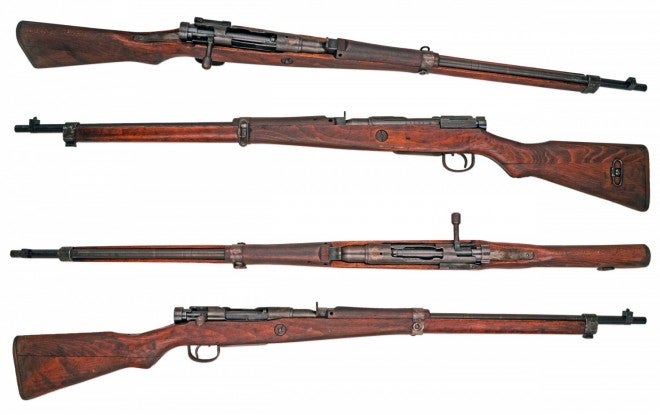
A “last ditch” late model Type 99. Note the extremely simple sights, barrel-shaped bolt handle, and lack of a top front handguard. Image source: candrsenal.com
Type 99 production ended with the cessation of hostilities in 1945, when its service life for all intents and purposes ended as well. The rifles would soldier on other hands in later conflicts in the Pacific and Asia, but when the Japanese took up arms again in 1954 with the creation of the Self-Defense Force, it was not Type 99s that were issued, but surplus US M1 Garands.
Overall, the Type 99 is an underrated and underappreciated rifle, which thanks to its sound design and chrome-lined bore is a strong contender for the title of “best bolt-action rifle of the war.” Paradoxically, the last-ditch late-war examples are also some of the worst bolt-actions of the war, and have contributed significantly to the rifle’s mediocre reputation among American milsurp enthusiasts. That, however, is beginning to change as appreciation grows for the fascinating and eminently collectible Type 99.
A very big thank you to Othais, of C&Rsenal, who helped tremendously with ensuring the accuracy of the information presented in this article. I learned a lot about the Type 99 by talking to him, and it’s well worth your time to pay his website and YouTube channel a visit, where you too can learn all sorts of cool things. All his images and videos in this article were used with permission.
A US Army manual for the Type 99 is available at this link here. Also, a 1943 report on Japanese infantry weapons contains some period information on the rifle. Anyone wishing to read the markings on their Type 99 should consult this page at oldmilitarymarkings.com.
 Your Privacy Choices
Your Privacy Choices
